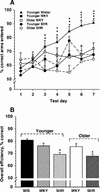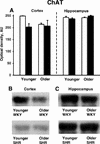Spontaneously hypertensive rats: further evaluation of age-related memory performance and cholinergic marker expression
- PMID: 12790160
- PMCID: PMC161744
Spontaneously hypertensive rats: further evaluation of age-related memory performance and cholinergic marker expression
Abstract
Objective: The spontaneously hypertensive rat (SHR), often used to study cardiovascular disease processes, may also be utilized to model certain central nervous system changes associated with memory disorders. Previous work in our laboratory indicated that central nicotinic acetylcholine receptors are markedly diminished and that memory-related task performance is impaired in this rodent phenotype. Due to the well-documented importance of the central cholinergic system to memory processes and its vulnerability to the effects of aging, it was of interest to measure other cholinergic markers and to further evaluate memory function in older SHRs.
Method: Radial arm maze performance was used to assess working memory, quantitative receptor autoradiography with [3H]-pirenzipine, [3H]-AFDX-384 and [3H]-epibatidine (combined with cytisine) was used to determine the densities of muscarinic-M1 and -M2 and nicotinic cholinergic alpha3 receptors, respectively. Immunoblotting experiments were also used to determine the expression of the presynaptic cholinergic markers, choline acetyltransferase and the vesicular acetylcholine transporter.
Results: Radial arm maze performance was impaired in hypertensive (compared with normotensive Wistar and Wistar-Kyoto) rats, regardless of age. M1 binding was increased in frontal and prefrontal cortical areas in SHR (p < 0.05), whereas M2 densities were higher in the hypertensive phenotype in the caudate putamen. A lower expression of alpha3-containing nicotinic receptors was observed in the superior colliculus in SHRs. Age-related differences in the expression of the vesicular acetylcholine transporter were noted in the hippocampus.
Conclusion: The SHR may be useful to model some aspects (particularly hypertension-related) of memory disorders, especially those in which cholinergic function is altered.
Objectif: Le rat spontanément hypertendu (RSH), souvent utilisé pour étudier les phénomènes morbides cardiovasculaires, peut aussi servir à modéliser certains changements du système nerveux central associés à des troubles de la mémoire. Des travaux antérieurs réalisés dans notre laboratoire ont indiqué que l'activité des récepteurs centraux de l'acétylcholine nicotinique diminue sensiblement et que l'exécution des tâches reliées à la mémoire est réduite chez ce phénotype de rongeurs. En raison de l'importance bien documentée du système cholinergique central pour les processus de la mémoire et de sa vulnérabilité aux effets du vieillissement, il s'avérait intéressant de mesurer d'autres marqueurs cholinergiques et d'évaluer davantage la fonction mémoire chez des RSH plus âgés.
Méthodes: On a utilisé les résultats du test du labyrinthe en étoile pour évaluer la mémoire au travail, l'autoradiographie des récepteurs quantitatifs avec la [3H]-pirenzipine, [3H]-AFDX-384 et [3H]-épibatidine (combinée à la cytisine) pour déterminer les densités des récepteurs muscariniques M1 et M2 et cholinergiques nicotiniques α3 respectivement. On a aussi utilisé des expériences de transfert pour déterminer l'expression des marqueurs cholinergiques présynaptiques, de la choline-acétylase et du transporteur vésiculaire de l'acétylcholine.
Résultats: Les résultats du test du labyrinthe en étoile ont diminué chez les rats hypertendus (comparativement à des rats Wistar et Wistar-Kyoto normotendus), sans égard à l'âge. La fixation de M1 dans les régions du cortex frontal et préfontal était accrue chez les RSH (p < 0,05), tandis que les densités de M2 étaient plus élevées dans le putamen caudé chez le phénotype hypertendu. On a observé une expression réduite des récepteurs nicotiniques contenant de l'α3 dans le colliculus supérieur chez les RSH. Dans l'hippocampe, on a constaté des différences liées à l'âge dans l'expression du transporteur de l'acétylcholine vésiculaire.
Conclusion: Le RSH peut être utile pour modéliser certains aspects des troubles de la mémoire (reliés particulièrement à l'hypertension), spécialement dans les cas où la fonction cholinergique est modifiée.
Figures





Similar articles
-
Deficits in spatial learning and nicotinic-acetylcholine receptors in older, spontaneously hypertensive rats.Neuroscience. 2000;101(2):357-68. doi: 10.1016/s0306-4522(00)00377-8. Neuroscience. 2000. PMID: 11074159
-
Cognitive impairment in spontaneously hypertensive rats: role of central nicotinic receptors. I.Brain Res. 1997 Oct 10;771(1):89-103. doi: 10.1016/s0006-8993(97)00793-2. Brain Res. 1997. PMID: 9383012
-
Dahl salt-sensitive and salt-resistant rats: examination of learning and memory performance, blood pressure, and the expression of central nicotinic acetylcholine receptors.Neuroscience. 2001;103(2):351-63. doi: 10.1016/s0306-4522(00)00569-8. Neuroscience. 2001. PMID: 11246150
-
Autoradiographic comparison of muscarinic M1 and M2 binding sites in the CNS of spontaneously hypertensive and normotensive rats.Brain Res. 1997 Oct 17;771(2):173-83. doi: 10.1016/s0006-8993(97)00691-4. Brain Res. 1997. PMID: 9401737
-
Time-dependent cognitive deficits associated with first and second generation antipsychotics: cholinergic dysregulation as a potential mechanism.J Pharmacol Exp Ther. 2007 Mar;320(3):961-8. doi: 10.1124/jpet.106.106047. Epub 2006 Sep 11. J Pharmacol Exp Ther. 2007. PMID: 16966470 Review.
Cited by
-
Mild cognitive impairment: animal models.Dialogues Clin Neurosci. 2004 Dec;6(4):369-77. doi: 10.31887/DCNS.2004.6.4/gpepeu. Dialogues Clin Neurosci. 2004. PMID: 22034045 Free PMC article.
-
Post-stroke brain can be protected by modulating the lncRNA FosDT.J Cereb Blood Flow Metab. 2024 Feb;44(2):239-251. doi: 10.1177/0271678X231212378. Epub 2023 Nov 7. J Cereb Blood Flow Metab. 2024. PMID: 37933735 Free PMC article.
-
Comparative analysis of the persistence of a conditioned passive avoidance reflex in rats with different forms of inherited hypertension.Neurosci Behav Physiol. 2007 Jul;37(6):577-82. doi: 10.1007/s11055-007-0055-y. Neurosci Behav Physiol. 2007. PMID: 17657428
-
The Potential Therapeutic Capacity of Inhibiting the Brain Renin-Angiotensin System in the Treatment of Co-Morbid Conditions in Epilepsy.CNS Drugs. 2019 Nov;33(11):1101-1112. doi: 10.1007/s40263-019-00678-4. CNS Drugs. 2019. PMID: 31680223 Review.
-
Review of rodent models of attention deficit hyperactivity disorder.Neurosci Biobehav Rev. 2022 Jan;132:621-637. doi: 10.1016/j.neubiorev.2021.11.041. Epub 2021 Nov 27. Neurosci Biobehav Rev. 2022. PMID: 34848247 Free PMC article. Review.
References
-
- Elias MF, Wolf PA, D'Agostino RB, Cobb J, White LR. Untreated blood pressure level is inversely related to cognitive functioning: the Framingham Study. Am J Epidemiol 1993;138:353-64. - PubMed
-
- Launer LJ, Masaki K, Petrovich H, Foley D, Havlik RJ. The association between midlife blood pressure level and late-life cognitive function: the Honolulu-Asia Aging Study. JAMA 1995;274:1846-51. - PubMed
-
- Hebert R, Lindsay J, Verreault R, Rockwood K, Hill G, Dubois MF. Vascular dementia: incidence and risk factors in the Canadian study of health and aging. Stroke 2000;31:1487-93. - PubMed
-
- Breteler MMB. Vascular risk factors for Alzheimer's disease: an epidemiologic perspective. Neurobiol Aging 2000;21:153-60. - PubMed
-
- Skoog I, Lernfelt B, Landahl S, Palmertz B, Andreasson LA, Nilsson L, et al. 15-year longitudinal study of blood pressure and dementia. Lancet 1996;347:1141-5. - PubMed
Publication types
MeSH terms
Substances
LinkOut - more resources
Full Text Sources
Medical
